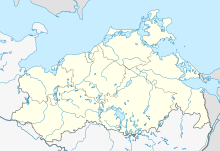Rugenseemoor nature reserve
Coordinates: 53 ° 50 ′ 42.1 ″ N , 11 ° 49 ′ 40 ″ E
The Rugenseemoor nature reserve is a nature reserve in the Schlemminer Forest in Mecklenburg-Western Pomerania . It covers eight hectares and is two kilometers west of the village of Katelbogen . The legal expulsion took place on October 1, 1990 with the aim of protecting and preserving a boiler moor with rare animal and plant species. The areas are part of the FFH area Schlemminer Forests and Small Water Landscape .
The state of the area is rated as good. The hydrological conditions are not disturbed and nutrient inputs from neighboring areas have been minimized since 1997 by afforestation of a wood border with native tree species. The nature reserve may not be entered. A forest path borders the eastern part.
history
The Rugenseemoor emerged as a form of dead ice after the last Ice Age , south of the high castle moraine complex . The drainless depression silted up in the next millennia and then mossed. The final stage of this process was a rain bog fed only by surface water . The first human settlement can be proven by well-preserved Neolithic barrows not far to the north and a large stone grave to the east near Katelbogen. The High Castle near Schlemmin was an early Slavic settlement. In the 18th century, the moor was drained to the east via a ditch. At the beginning of the 20th century the areas were supposed to be afforested, which was unsuccessful due to the high humidity in the area. The trench was closed again in 1982.
Flora and fauna
There are the typical representatives of a Sauer-Zwischenarmmoor: cranberry , trunkberry , round-leaved sundew , swamp porst and cotton grass .
47 species of hoverflies were detected. The moor is home to numerous types of dragonflies, including the little moss damsel , Nordic moss damsel , great moss damsel , spotted and common emerald dragonfly , early adonis dragonfly , horseshoe and cup damsel . The reptile fauna is determined by common toad , fire-bellied toad , foliage , grass , pond and bog frog , grass snake and adder . Cranes , wood sandpipers and miniature flycatchers breed in the area .
literature
- Rugenseemoor 234 . In: Ministry of Environment Mecklenburg-Western Pomerania (Hrsg.): The nature reserves in Mecklenburg-Western Pomerania . Demmler-Verlag, Schwerin 2003, ISBN 3-910150-52-7 , p. 504 f .
- FFH area 2137-302 "Schlemmin forests and small watercourses" management plan. Forest section. (PDF) Ministry of Agriculture, Environment and Consumer Protection, 2007, p. 64 , accessed on May 22, 2009 .
Web links
- Map portal environment of the State Office for the Environment, Nature Conservation and Geology Mecklenburg-Western Pomerania ( information ) with geodata
Individual evidence
- ↑ Tumulus. In: Kleks-online.de. Retrieved January 30, 2013 .
- ^ Great stone grave (Katelbogen 1). In: Kleks-online.de. Retrieved January 30, 2013 .
- ↑ High Castle (Schlemmin 3). In: Kleks-online.de. Retrieved January 30, 2013 .


